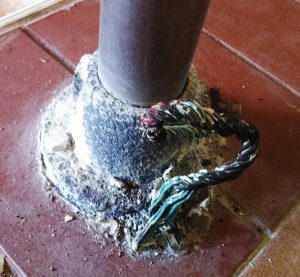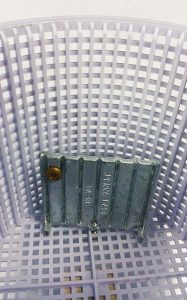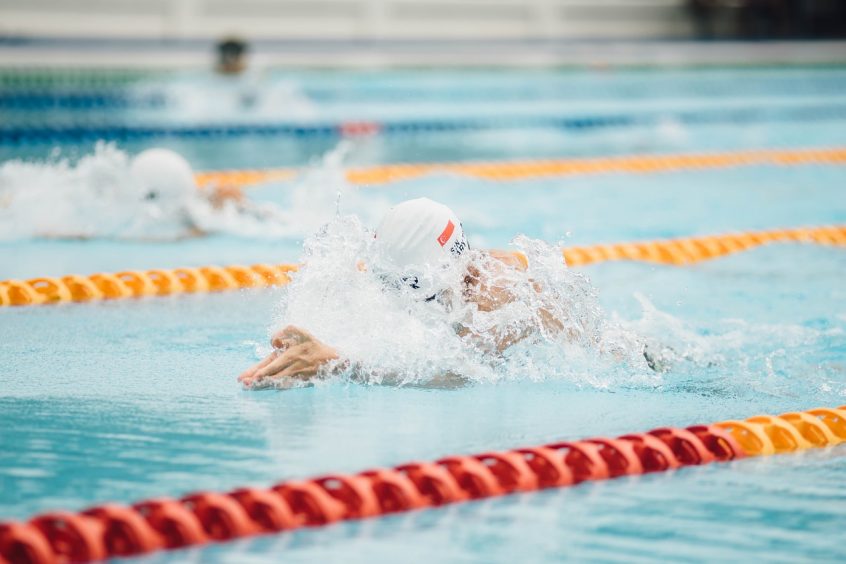Steel pool walls are eroding and ladder handrails are turning black. New heaters are failing after one year and warranties are void because the casing was not bonded. What is going on here? The pool industry has some difficult-to-grasp concepts such as water chemistry; where on the surface it seems easy enough to resolve, but when traditional remedies do not fix the problem, customers are left without answers. There is no better example of this than galvanic corrosion and, more specifically, the damage it can potentially cause to pools, spas, and peripheral components. Understanding how and why galvanic corrosion occurs can help those in the field provide better service to their customers.
What is galvanic corrosion?
Galvanic corrosion is an electromechanical process where a potential difference, measured as voltage, exists between dissimilar metals and alloys when they are placed in electrical contact within an electrolytic solution. For instance, placing two different metals into salt water will make a basic battery. Using a voltmeter, voltage can be measured between the differing metals that are in contact with the water. In essence, a saltwater pool is a large battery that can generate a potential difference across any differing metals introduced to the water.
Stainless steel, galvanized steel, aluminum (Al), brass, copper (Cu), and titanium (Ti) are all commonly found in pools and related equipment, which is one reason why these corrosion-related failures occur.
All pools using chlorine (Cl) can potentially contain enough salt to allow for the water to conduct electricity. In the case of saltwater chlorine pools, the risk and the ensuing damage from galvanic corrosion is greater as salt levels are much higher.
Following this logic, ships that operate in saltwater seas have extensive protection systems in place to mitigate this problem. The salinity of ocean water is roughly 35,000 parts per million (ppm), which is 10 times more than a typical saltwater pool. These extremely harsh conditions have long since exposed the destructive force of galvanic corrosion and the need to control the problems associated with salt water, metal, and electricity in a galvanic couple (the corrosive cell development when two different metals are separated by an electrolyte).
As a frame of reference, the sodium level in municipal tap water might range between 20 and 200 ppm, while a pool maintained with traditional chlorine may contain a sodium level between 300 to 1000 ppm. Sodium levels in saltwater pools typically average 3000 ppm. From zero ppm to the levels of salt found in sea water, the increase in galvanic activity is nearly linear as the sodium level increases.
Two different metals submerged in salt water may have a potential difference between them, allowing an electrical current to pass from the least noble metal (anode) and travel through the electrolyte (salt water) to the more noble, less active metal (cathode). During this process, the electric current results in advanced corrosion of the anode as it dissolves into the electrolyte (i.e. galvanic corrosion), and inhibited corrosion of the cathode (i.e. cathodic protection). The greater the electrolyte’s conductivity in the solution, the greater the damaging effects of the electrochemical process.
That said, pool water is an electrolytic solution. Pure water does not conduct electricity; however, impurities in the water do. Salt, in particular, is a good conductor, and since chlorine—in all forms—is sodium based, all pools using this sanitizer are at risk of galvanic corrosion. This means the damaging effects multiply as the salt levels increase (due to the increased conductivity of the water). Therefore, saltwater pools have an elevated risk for this type of damage. To prevent this destructive process, a fair amount of electrical comprehension is required.
Make sure clients are aware

Here, the bonding wire as well as the metal ladder anchors has experienced severe decay, while the stainless rail is relatively corrosion-free.
The complicated nature of this problem is often the reason why pool owners are not made fully aware of the potential risks associated with saltwater chlorine pools. These pools certainly have some advantages, such as the water being softer and less irritable to bather’s skin and eyes; however, to make an informed decision, pool owners should be made aware of what can happen and what can be done to mitigate the risks.
Should a pool be hampered by any one of the following perils, increasing the salt levels in the water via a chlorine generator should not be considered an option.
Pools with bonding grids that are old, out of date, undersized, or the condition is unknown should be electrically renovated prior to installing a saltwater chlorine system. In the event the pool is not bonded and grounded, the damage from galvanic corrosion can be very aggressive.
Pools with poorly maintained water chemistry are more likely to experience problems from galvanic corrosion. For instance, pH values outside the ideal range can increase the rate of damage. This is another subject that should be discussed with the pool owner so they understand the importance of proper water chemistry.
Hot tubs, spas, and warm water pools will have greater galvanic corrosion activity than cold-water environments.
Pools equipped with gas heaters that have copper heat exchangers, which are not rated for sodium levels commonly associated with saltwater chlorine pools, may be prone to premature failure. Some pool and spa heaters have thicker exchangers or nickel steel heat exchangers, which are more resistant to the effects of galvanic corrosion.
Pools with active leaks or wicking that allow water, which contains conductive salt, to access steel wall panels, metal light niches, and areas where copper from the bonding grid is connected to metal components of the pool. The addition of an electrolyte solution to these areas will increase the rate of galvanic corrosion. One particular concern is the structural steel-reinforcing grid in the shell of concrete pools. Since the vast majority of these pools are not treated with waterproofing products, but instead employ a more porous water-resistant design using cementitious materials, the salt water can, and will, wick into the pool shell and access the critically important and non-serviceable reinforcing grid.
The path of least resistance
Bonding is the process of providing a direct, low-resistance electrical path between all metal components in a system—something all pools require. This prevents any metal components in the pool from developing a potential difference, which is not only dangerous for bathers, but also the primary risk factor for galvanic corrosion. Further, the bonding grid, and all electrically powered equipment, must be grounded. This gives any electrical currents developed in the pool a non-destructive method to escape.
With this in mind, it is important to know the fundamental differences between bonding and grounding procedures as these concepts are often confused. To fully comprehend the risks of galvanic corrosion, it is important to be able to differentiate between the two.
Bonding
Bonding all metal items in and around a pool effectively makes the electrical potential of all items equal to each other. If a potential difference cannot exist between two metal components, a current cannot be transferred between them and, ultimately, galvanic corrosion will not occur.
This also protects bathers from electrocution. Keeping the pool and all peripheral components at the same electrical potential prevents bathers from completing a circuit and providing a low-resistance path between two differing electrical potentials.
Grounding
Earth grounding is the process of connecting electric-powered items to the lowest electrical potential, or zero voltage, for the purpose of protecting against a potential fault in the system. While the term ‘ground’ is used, it is not actually a universal standard, as the ground in one area may have a slightly different electrical potential than a ground in another area.
The function of grounding electrical equipment is to provide a low-resistance path to zero electrical potential should a voltage develop somewhere it should not be (e.g. a heater or pump casing). If an electrical fault energizes a pump or heater casing, the low-resistance path to ground—from the grounding wire—will immediately cause a current spike as the unrestricted current races towards zero potential. This current increase will heat up a small piece of metal in the circuit breaker causing it to ‘trip’ or disconnect from the power supply.
Bonding and grounding work in tandem. Collectively, the bonding grid ties the metal components of the pool together so everything has the same electrical potential, while the grounding wire ensures the electrical potential is equal to zero. Today, pool design specifically deals with the harmful effects of electrical current in the water as a result of differences in electrical potential. Adding a saltwater chlorine generator not only increases the water’s conductivity, but also has a number of adverse effects on these protection systems.
How galvanic corrosion can damage bonding grids
One of the primary causes of galvanic corrosion is the proximity of differing metals to one another. The bonding grid comprises a copper wire that is attached to the pool’s various metal components. This creates multiple direct points of differing metal contact around the pool which can deteriorate from galvanic corrosion at an advanced rate. If the bonding grid becomes damaged or broken, the pool can become electrically unsafe, as well as experience an advanced rate of decay.
Without conducting an electrical conductivity test between all metal components in the pool, damage to the bonding grid might be noticed first by a sudden onset of the following symptoms:
- tiny shocks when touching various metal components in and around the pool area;
- colour changes in metal components; and
- corrosion forming suddenly on multiple metal components within the pool system.
Without a functional bonding grid, a potential difference can exist between different metal components, allowing a non-stop, destructive current to travel between them. While this is a concern for all pools, increasing the salt level (in saltwater pools) reduces the electrical resistance of the water and, as a result, it becomes more conductive.
Electrical currents in the water will not only damage metal components, but also more specifically, attack the pool’s protection system (i.e. the bonding grid), which helps mitigate this type of electromechanical damage.
Pool water containing high levels of salt causes a multi-fold increase in the amount of current travelling between potential differences created by metal components. This process, when applied constantly over a long period of time, can eventually cause the pool structure to fail. Galvanic corrosion can also damage or even sever the grounding wire or bonding points between the pool and the copper bonding grid. If this occurs, the pool may no longer have a low-resistance path to ground.
How to reduce the risk

An inline sacrificial anode installed on a pool system.
Despite the risks described, there are ways to reduce the chances of damage. In pools, the least noble metal in the galvanic couple becomes the anode and assumes the brunt of damage as a result of galvanic corrosion. This process of protecting certain metals by making them the cathode in a galvanic couple is called cathodic protection.
Sacrificial anodes
Cathodic protection involves adding sacrificial anodes to the pool to become the primary line of defense against galvanic corrosion. For example, an active metal such as zinc (Zn) will be the most inclined to decay as it will become the least noble metal in the pool.
Since it is not possible to stop or prevent galvanic corrosion given the nature of how pools are built, the next best thing is to try and control any possible damage by providing a sacrificial anode to decay rather than less serviceable pool components. An inline sacrificial anode is a small plumbing fixture typically made with a zinc rod connected to a bonding lug. The zinc will be the least noble metal in the pool water and the bonding lug will provide an additional low-resistance path to ground for any currents that develop as part of the galvanic corrosion process. While the sacrificial anode will serve to provide a general level of protection for the pool system, localized anodization of components can still occur in some areas.
Additional anodes
Since most pools are quite large, a single anode located in the pump room will only protect against a portion of the total potential for damage. Adding additional anodes to the pool will increase protection; however, it is not realistic to think the more anodes added will eliminate any and all damage.
The amount and, more importantly, location of metal components in the pool system is such that it is not always possible to have anodes everywhere they need to be. Much as the name suggests, the anode metal is sacrificed in providing protection to the cathode and must be able to be replaced as it deteriorates. Zinc anodes made to connect directly to handrails and ladders, as well as zinc discs which are intended to sit in the skimmer basket are available.

Zinc anode discs, intended to sit in the skimmer basket, are also available.
Improved bonding grids
Bonding grids should also be updated to current standards on older pools where their condition, or existence, is in question. This would be applicable to most large-scale renovation projects where steel components (e.g. walls, ladder anchors, light niches, and coping) can be accessed.
Due to the general misunderstanding of how pool grounding and bonding works—especially on older pools—many were not installed correctly. Therefore, when undertaking an extensive pool renovation project, it is strongly recommended that a bonding grid system be installed, along with proper grounding of all equipment—especially if the client wants a saltwater chlorine system.
Lower salt levels
The destructive currents caused by galvanic corrosion are directly tied to the level of salt in the pool water. For this reason, using a saltwater chlorine generator that operates at lower salt levels will reduce the harmful effects on the pool. Previously, it was common to have saltwater systems that operated between 2800 and 4000 ppm sodium. Recently, however, systems have become available which operate effectively at levels closer to 1500 ppm. If saltwater chlorination is an option, consider installing low salt units to reduce the potential for pool damage.
In the know
Without questioning the validity of the product itself, the reality is, adding salt to a pool increases the potential for damage. Understanding the nature of the problem will go a long way in helping to understand why galvanic corrosion is a concern and what can be done to control it. Keep in mind, there is no silver bullet solution that will guarantee complete protection against this destructive process. This is a fact every pool owner considering saltwater chlorination should consider to make an informed decision about what is best for them and the longevity of their pool.
This article was written by Steve Goodale and originally appeared on Pool & Spa Marketing [link].
